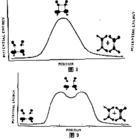1) intense femtosecond laser pulse


飞秒强激光脉冲
1.
The dependence of the maximum energy of protons E_max produced in the interaction of an intense femtosecond laser pulse(60 fs, 790 nm,2×10~16 W/cm~2) with hydrogen clusters in a gas jet on the square of the cluster radius r~2_c has been investigated experimentally.
报道了飞秒强激光脉冲(60 fs,790 nm,2×1016W/cm2)与纳米尺寸的氢团簇(半径rc约为1~3 nm)相互作用,产生的最大质子能量Emax对于团簇半径rc相关性的实验研究结果。
2) high-intensity femtosecond laser pulse


高强度飞秒激光脉冲
1.
Self-compression of high-intensity femtosecond laser pulses in air;


高强度飞秒激光脉冲在空气中的自压缩
3) Femtosecond pulse intense laser field


飞秒脉冲强激光场
4) Femtosecond laser pulse


飞秒激光脉冲
1.
Numerical study on a femtosecond laser pulse in photonic crystal fiber;


光子晶体光纤中飞秒激光脉冲传输的研究
2.
Propagation of a femtosecond laser pulse with duration of several optical periods of oscillation in a linear dispersive medium;
具有几个光振荡周期长度的飞秒激光脉冲在线性色散介质中的传输
3.
Evolvement of filamentation of femtosecond laser pulses of a kHz repetition rate propagating in Air;
1kHz飞秒激光脉冲在空气中传输成丝的演化过程
5) femtosecond pulse laser


飞秒脉冲激光
1.
From the microscopic view point of energy transfer,energy transfer mechanism of femtosecond pulse laser radiation on metal film and the resulted molecules desorption from substrate is discussed.
从微观能量传输角度,对飞秒脉冲激光的辐射传热及其产生的金属薄膜吸附层分子脱附过程的能量输运机理进行了研究。
2.
The ultrafast process in semiconductor was studied by using femtosecond pulse laser.


用飞秒脉冲激光技术研究了半导体中的超快过程。
3.
Methods: Fresh canine kidneys and porcine ureters were harvested and subjected to thulium laser and femtosecond pulse laser, respectively.
方法:分别采用铥激光和飞秒脉冲激光对离体犬肾组织和猪输尿管组织进行体外实验,观察(1)在模拟腹腔条件下,低流量冲洗液抑制铥激光产生烟雾的效果和(2)飞秒脉冲激光切割离体猪输尿管的效率与副损伤程度。
6) femtosecond laser


飞秒脉冲激光
1.
An experimental study of supercontinuum generation in a photonic crystal fiber with zero dispersion wavelength 780?nm by femtosecond laser and its dependence factor is presented.
在不同功率、不同中心波长、不同啁啾和有无直流成分的多种飞秒脉冲激光的条件下 ,研究了超连续光谱的产生情况 。
2.
We explore a way to induce nanometer structure on silicon surface by femtosecond laser ablation.
我们探索了一种利用飞秒脉冲激光在Si表面诱导纳米微结构的方法。
补充资料:飞秒化学

飞秒化学
飞秒化学是物理化学的一支,研究在极小的时间内化学反应的过程和机理。这一领域涉及的时间间隔短至约千万亿分之一秒,即1飞秒,这也就是名称的来源。
1999年,艾哈迈德·泽维尔(zewail a)因他在这一领域的开创性的研究而获得诺贝尔化学奖。泽维尔运用飞秒激光光束拍摄下反应过程中的变化及生成的中间体。
现在,运用飞秒化学技术可以观察到,反应过程中生成的中间产物与起始物和最终产物都不同。可以预见,运用飞秒化学,化学反应将会更为可控,新的分子将会更容易制造。
飞秒科学技术的发展已有近20年历史,80年代末泽维尔教授做了一系列试验,他用可能是世界上速度最快的激光闪光照相机拍摄到一百万亿分之一秒瞬间处于化学反应中的原子的化学键断裂和新形成的过程。这种照相机用激光以几十万亿分之一秒的速度闪光,可以拍摄到反应中一次原子振荡的图像。他创立的这种物理化学被称为飞秒化学,飞秒即毫微微秒(是一秒的千万亿分之一),即用高速照相机拍摄化学反应过程中的分子,记录其在反应状态下的图像,以研究化学反应。常规状态下,人们是看不见原子和分子的化学反应过程的,现在则可以通过泽维尔教授在80年代末开创的飞秒化学技术研究单个原子的运动过程。
泽维尔的实验使用了超短激光技术,即飞秒光学技术。犹如电视节目通过慢动作来观看足球赛精彩镜头那样,他的研究成果可以让人们通过“慢动作”观察处于化学反应过程中的原子与分子的转变状态,从根本上改变了我们对化学反应过程的认识。泽维尔通过“对基础化学反应的先驱性研究”,使人类得以研究和预测重要的化学反应,泽维尔因而给化学以及相关科学领域带来了一场革命。
说明:补充资料仅用于学习参考,请勿用于其它任何用途。